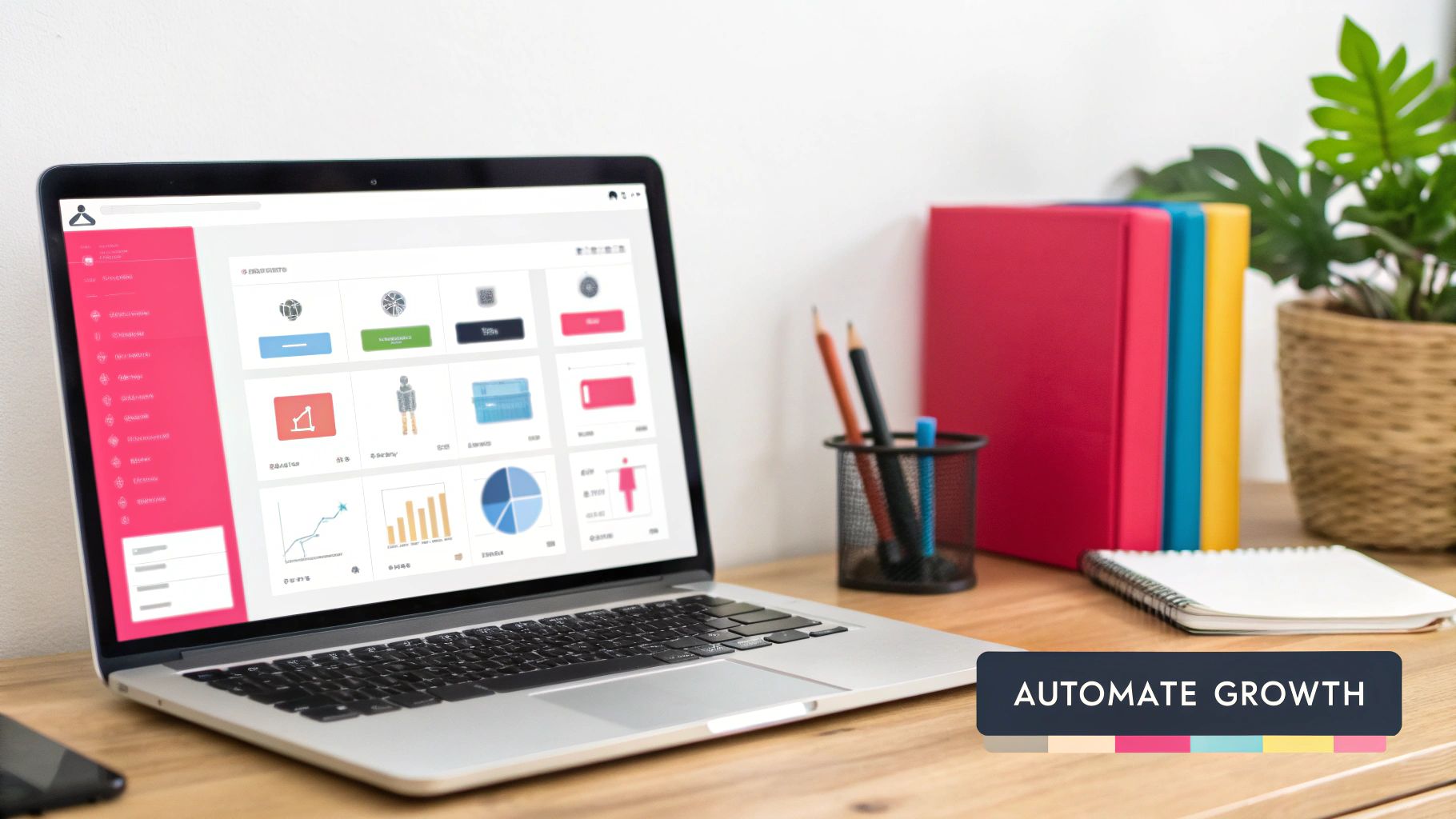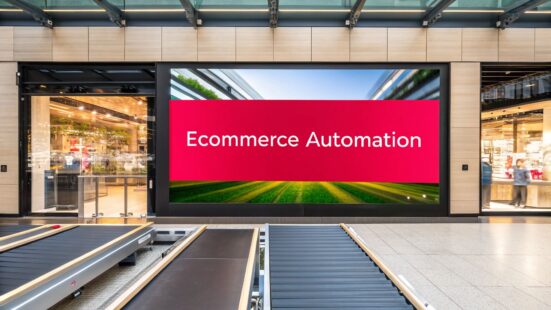 How to Monetize Mobile Apps for Maximum Revenue
How to Monetize Mobile Apps for Maximum Revenue
Think of ecommerce marketing automation not as some complex, intimidating tech, but as your most reliable team member. This is the employee who works 24/7, never calls in sick, and handles all the repetitive, yet critical, marketing tasks with perfect precision. It's the engine that powers your growth, freeing up your human team to focus on strategy, creativity, and the big-picture ideas that move the needle.
Table of Contents
What Is Ecommerce Marketing Automation?

At its heart, ecommerce marketing automation is all about using software to deliver personalized, timely, and relevant experiences to every single customer—automatically and at scale. It’s what allows a small team to communicate with thousands of customers as if they were having a one-on-one conversation.
To really get it, it helps to have a general understanding of automation in a broader sense. In ecommerce, we're just pointing that power directly at customer engagement and sales.
And it's not just a nice-to-have; it's a massive growth driver. The marketing automation market is on track to hit $15.62 billion by 2030. Why? Because it works. On average, companies see a return of $5.44 for every dollar spent on it. That’s a powerful testament to its impact on the bottom line.
How Automation Works in Practice
The real magic of ecommerce marketing automation lies in its simple but powerful "trigger-and-action" system. A customer does something (a trigger), and your system automatically responds with a pre-planned action.
Key Concept: Automation platforms use customer actions (triggers) to launch predefined marketing responses (actions). This creates a personalized and scalable communication system that responds to individual customer journeys in real time.
This cause-and-effect model is the secret to building seamless, personalized journeys that don't fall apart as you grow. It’s how you make every customer feel noticed without burning out your team.
At the center of any automation strategy are a few core components that make everything tick. Think of them as the basic building blocks you'll use to construct your customer journeys.
Core Automation Concepts at a Glance
| Component | Description | Example |
|---|---|---|
| Triggers | These are the specific customer behaviors that kick off an automated response. They act as the "if" in an "if-this-then-that" sequence. | A customer signs up for your newsletter, adds an item to their cart, or views a product three times in one week. |
| Actions | This is the predefined task the software executes once a trigger is activated. It's the "then" part of the equation. | Sending a welcome email, texting a cart recovery link, or adding a "high-intent" tag to a customer's profile. |
| Workflows | A workflow is a sequence of triggers and actions designed to guide a customer through a specific journey. It's the full recipe, not just the ingredients. | A new subscriber workflow might send a welcome email immediately, a "best-sellers" email three days later, and a 10% discount a week later. |
Understanding these three pieces—triggers, actions, and workflows—is the foundation. Once you master how they fit together, you can build incredibly sophisticated and effective marketing systems that run on their own, nurturing leads and driving sales while you sleep.
The True Impact of Automation on Your Business

Alright, let's move past the theory. What does bringing ecommerce marketing automation into your business actually look like day-to-day? This isn't just about making things a little faster; it’s about completely rethinking how you make money, talk to your customers, and use your team's most precious resource—time.
Think about your marketing team right now. How many hours get eaten up by repetitive stuff? We're talking about sending follow-up emails, painstakingly segmenting lists by hand, or poking individual shoppers about their abandoned carts. Automation is like hiring a tireless assistant who handles all of that, 24/7, without a single mistake.
The immediate result is a massive time-saver. Instead of drowning in operational details, your team gets to do what people are great at: thinking big, getting creative, and building a brand that people genuinely connect with. They can spend their days analyzing what's working, cooking up new campaigns, and innovating—not just keeping the lights on.
Amplify Your Revenue Streams
One of the first things you'll notice is the direct impact on your bottom line. Automation is a beast at capturing sales that would have otherwise slipped through the cracks and systematically increasing what each customer spends with you.
Just think about these classic, money-making scenarios:
- Abandoned Cart Recovery: Someone's about to buy, but gets distracted and leaves. Bam! Automation kicks in, sending a perfectly timed email or SMS with a reminder. Maybe it includes a great customer review or a small discount to nudge them over the finish line. This one workflow alone can claw back a huge chunk of lost revenue.
- Cross-selling and Upselling: A customer buys a new camera. A week later, your system automatically sends them an email showing off a compatible lens or a slick camera bag. It feels helpful, not salesy, because it’s perfectly relevant. And just like that, you've increased your average order value.
- Customer Win-Back Campaigns: You notice a customer hasn't bought anything in 90 days. An automated "we miss you" flow gets triggered, sending a special offer to remind them why they loved your brand in the first place.
Achieve Personalization at Scale
In a crowded market, generic marketing is invisible. Real loyalty comes from making every single customer feel like you get them. Trying to do that manually for thousands of people is a recipe for burnout. With ecommerce marketing automation, it's just how you operate.
By tracking customer behavior—what they buy, what pages they look at, which emails they open—automation platforms build incredibly detailed customer profiles. This data is the fuel for delivering hyper-relevant content that truly connects.
Someone who only buys running shoes shouldn't get spammed with emails about hiking gear. A VIP customer who shops with you all the time deserves a heads-up on new sales. Automation handles this level of detail without breaking a sweat, creating custom-tailored experiences that build serious brand loyalty and keep customers coming back.
The connection between this kind of smart marketing and real growth is crystal clear. One analysis found that among companies rocketing ahead with 30% to 50% growth, a whopping 85.7% were using marketing automation. On the flip side, of the companies that didn't grow, the majority (59.5%) weren't using it at all. You can dive into the full breakdown and see what's next by checking out these upcoming marketing automation trends on connectif.ai. The numbers don't lie: automation isn't just a nice-to-have tool; it's a fundamental part of any modern growth strategy.
Alright, let's get into the nitty-gritty. Theory is great, but putting ecommerce marketing automation into practice is where you really start to see the money roll in. When you set up the right systems, you can consistently connect with customers at the most critical points in their journey.
These automated sequences are your silent sales team, working 24/7. They're designed to build relationships, win back lost sales, and foster long-term loyalty—all without you needing to hit "send" on every single message.
The Foundational Welcome Series
Think of your welcome series as the first real conversation you have with someone who just raised their hand and said, "I'm interested." This is your golden opportunity to make a killer first impression, show them what you're all about, and gently guide them toward that first purchase. A single welcome email just won't cut it; a multi-step sequence is where the magic happens.
The goal here isn't a hard sell right out of the gate. It's about starting a relationship.
- Email 1 (Sent Immediately): Deliver on your promise. If you offered a discount for signing up, give it to them now. Welcome them to the community and share a quick, compelling bit about your brand's story or what makes you different.
- Email 2 (Sent 1-2 Days Later): Show off the good stuff. Highlight your best-selling products or most popular collections. This helps new subscribers figure out what you're known for and gives them a clear place to start browsing.
- Email 3 (Sent 3-5 Days Later): Build that all-important trust. Share some social proof like customer reviews, photos from other happy buyers, or a shout-out you got in the press. You can also use this email to answer common questions or reinforce perks like your return policy or fast shipping.
Recovering Lost Sales With Abandoned Cart Workflows
Abandoned carts are a goldmine. Seriously. These shoppers were this close to buying. They've shown clear intent by adding items to their cart; they just need a little nudge to get across the finish line. A well-crafted abandoned cart workflow is one of the fastest ways to see a direct return from your automation efforts.
Key Takeaway: A top-tier abandoned cart series is more than a simple "Hey, you forgot this!" email. It's a strategic, multi-touch strategy that tackles potential roadblocks, reminds them of the value, and adds a touch of urgency.
Here’s a multi-channel flow that flat-out works:
- Email 1 (Sent 1-3 Hours After Abandonment): This is the gentle reminder. Keep the tone helpful, not pushy. Something like, "Did you forget something?" or "Your items are waiting!" works wonders. Make sure to include pictures of the actual items they left behind.
- Email 2 (Sent 24 Hours Later): Time to overcome objections. Include a glowing review for one of the products in their cart or remind them of your awesome returns policy. This helps ease any hesitation they might be feeling.
- Email 3 or SMS (Sent 48-72 Hours Later): Create a little friendly urgency. A small, time-sensitive discount or a free shipping offer can be incredibly persuasive for shoppers who are still on the fence.
To see how these individual workflows connect to a bigger picture, this chart shows how knowing your audience (segmentation) and sending automatic messages (triggers) leads to results you can actually measure.

The infographic hammers it home: successful automation starts with understanding who you're talking to, delivering the right message at the right time automatically, and then paying close attention to what's working.
While the welcome and abandoned cart flows are non-negotiable, a few other key workflows can dramatically improve your customer lifecycle marketing.
| Comparing Top Automation Workflows |
| :— | :— | :— |
| Workflow Type | Primary Goal | Key Metric |
| Welcome Series | Nurture new leads, drive first purchase | Conversion rate, open rate |
| Abandoned Cart | Recover potentially lost revenue | Cart recovery rate, revenue |
| Post-Purchase | Increase loyalty, generate social proof | Review submission rate, repeat purchase rate |
| Win-Back Campaign | Re-engage inactive customers | Re-engagement rate, purchases from segment |
These four workflows form the backbone of a strong automation strategy, each playing a unique role in turning one-time buyers into loyal fans.
Driving Repeat Business With Post-Purchase Follow-Ups
The customer's journey doesn't stop once the payment goes through. That post-purchase window is a prime time to cement the relationship, get priceless feedback, and set the stage for their next order.
A well-timed follow-up shows you actually care about their experience, not just their credit card number. Once their order has been delivered, trigger a workflow asking for a product review. This gives you fantastic social proof for your website and makes the customer feel like their opinion matters. A couple of weeks down the line, you can send another message with tips on using their new item or suggest products that would be a perfect match.
Re-Engaging Lapsed Customers
It’s just a fact of business: some customers will eventually go quiet. A re-engagement campaign, often called a "win-back" flow, is your shot at waking up these dormant accounts before they're gone for good. By creating a segment of customers who haven't bought in a while (say, 90 or 180 days), you can automatically send them a series of emails reminding them why they liked your brand in the first place.
The power of these automated flows is undeniable. Email marketing is still a beast, and automated messages like cart reminders can generate up to 30 times more revenue per recipient than a standard one-off newsletter. What’s truly incredible is that 31% of all email orders come from these automated messages, even though they represent a tiny 1.8% of total emails sent. You can dig into these stats and discover additional marketing automation insights on EmailVendorSelection.com. The data doesn't lie—focusing on these key workflows delivers massive results.
How to Choose the Right Automation Platform

Picking your ecommerce marketing automation platform is a huge decision. It’s one of those choices that will echo through your entire strategy for years to come. This isn’t just about buying a piece of software; it’s about finding a true partner for your growth.
The right platform feels like a natural extension of your team. The wrong one? It’s a constant source of friction that holds you back.
There’s no magic, one-size-fits-all answer here. The tool that’s perfect for a massive brand shipping thousands of orders a day would be complete overkill for a new startup. Your decision has to be grounded in your business size, your budget, and what you’re actually trying to achieve.
To cut through the noise, you need a solid framework for evaluating your options. This will help you look past the slick sales pitches and focus on what really matters for your store.
Assess Your Core Needs First
Before you even think about booking a demo, take a hard look inward. You have to know what you need. It’s so easy to get distracted by flashy, advanced features you’ll probably never touch, while completely missing a deal-breaker on the fundamentals.
Start by asking some honest questions about where your business is today and where you genuinely see it in the next couple of years.
This internal audit is your best defense against overpaying for a platform loaded with features you don't need or, even worse, picking a tool you’ll have to replace in six months.
Crucial Insight: The best platform isn't the one with the longest feature list. It's the one that solves your specific problems and slots perfectly into how you already work.
Your entire evaluation should rest on three non-negotiable pillars: how it plays with your other tools, how it can grow with you, and how easy it is for your team to actually use.
The Three Pillars of Platform Evaluation
1. Seamless Integrations
Your marketing automation tool doesn't live on an island. It has to talk, constantly and flawlessly, with the very heart of your operation: your ecommerce platform.
- Ecommerce Platform: Does it have a deep, native integration with Shopify, WooCommerce, BigCommerce, or whatever you're running? A native connection is critical for instantly syncing data like purchases, customer profiles, and abandoned carts.
- Other Tools: Now, think about your whole tech stack. Does it connect smoothly with your help desk software, your reviews platform, or your loyalty program? The more your tools talk to each other, the more complete your customer picture becomes, unlocking seriously powerful automation.
2. True Scalability
The platform you choose today needs to be able to handle your business tomorrow. A tool that feels great with 5,000 contacts might start to choke and get expensive when you hit 50,000.
- Contact & Send Limits: Dig into the pricing tiers. What happens to the cost as your list grows and you send more emails? Watch out for platforms with punishing overage fees that essentially penalize you for being successful.
- Feature Availability: Are the really cool features, like predictive analytics or advanced split testing, locked away in an enterprise-level plan you can't afford? Make sure the capabilities you'll need down the road are actually within reach.
3. Intuitive User Experience (UX)
A platform can have all the power in the world, but if your team finds it impossible to use, it's worthless. A clunky interface or a confusing workflow builder will just slow you down and cause a lot of headaches.
- Workflow Builder: Is building an automation as simple as a drag-and-drop canvas, or does it feel like you need a developer on speed dial?
- Team Adoption: Can your marketing manager dream up a campaign and launch it themselves? The whole point is to empower your team, not create new bottlenecks.
Once you've sized up platforms against these three pillars, you can get into the nitty-gritty of the features that really move the needle in ecommerce marketing automation.
Key Features to Scrutinize
Not all features are created equal. For an ecommerce business, some capabilities have a much bigger impact on your bank account than others. Zero in on platforms that nail these areas.
| Feature Area | What to Look For | Why It Matters |
|---|---|---|
| Segmentation | The ability to create dynamic segments based on purchase history, site behavior, email engagement, and custom properties. | Powerful segmentation is the engine of personalization. It's what lets you send hyper-relevant messages that actually convert. |
| Reporting & Analytics | Clear, easy-to-understand dashboards that show workflow performance, revenue attribution, and key metrics like open rates and conversions. | You can't optimize what you can't measure. Strong analytics show you exactly which automations are making you money. |
| Multi-Channel Reach | Native support for both email and SMS marketing within the same platform. Bonus points for web push notifications or social media integrations. | Customers don't just live in their inbox. A unified platform lets you create cohesive journeys that meet people where they're most active. |
By using this structured approach—figuring out your needs, checking the three pillars, and then grilling the key features—you can confidently pick the right ecommerce marketing automation platform to power your brand's growth for years to come.
Best Practices for a Winning Automation Strategy
Having powerful tools is one thing; knowing how to use them is another game entirely. The real difference between high-performing ecommerce marketing automation and expensive background noise comes down to the strategy behind it all. True success isn't about flipping a switch on a dozen complex automations at once. It’s about being deliberate.
The smartest way to get started is to start simple and build momentum. Instead of trying to automate every possible customer interaction from day one, pour your energy into one or two workflows that can deliver a real impact. Master your abandoned cart sequence. Perfect your welcome series. Nail these foundational pieces, watch the revenue roll in, and then you can expand from a position of strength, not guesswork.
Personalize Everything with Smart Segmentation
Blasting out generic, one-size-fits-all messages is the fastest way to get your emails ignored, deleted, or worse, marked as spam. Great automation feels personal, and the engine that drives that feeling is smart segmentation. This is where you go beyond basic demographics and start grouping customers based on what they actually do.
Think of it like being a great shopkeeper. You wouldn't give the same sales pitch to every single person who walks through your door. You'd pay attention, see what they're looking at, and remember what they bought last time.
Your segmentation strategy should be digging into data points like:
- Purchase History: Group customers who buy "running shoes" separately from those who only buy "hiking gear."
- Purchase Frequency: Separate your VIPs who buy every month from the bargain hunters who only show up for Black Friday.
- Engagement Level: Create different buckets for people who open every email versus those who haven't clicked in 90 days.
- Website Behavior: Target shoppers who viewed a specific product three times but never added it to their cart.
This level of detail lets you send messages that are genuinely helpful and relevant. It’s how you transform your automation from robotic noise into a valued personal shopper.
Continuously Test and Optimize
One of the biggest mistakes brands make is treating automation as a "set it and forget it" tool. The market is always changing, customer tastes shift, and what worked wonders last quarter might be underperforming today. A winning strategy is built on a commitment to continuous testing and optimization.
The best marketers treat their automations like a science experiment. They are always testing a new hypothesis to improve performance, ensuring every automated message delivers maximum value.
Start A/B testing the crucial elements within your most important workflows. Can you beat your current abandoned cart open rate with a punchier subject line? Does adding an SMS to your welcome series give you a bump in first-time purchase conversions? Test everything: send times, calls-to-action, images, and copy. Even small, incremental improvements will add up to significant revenue gains over time.
Maintain the Human Touch
Finally, never forget that you're talking to people, not just data points on a spreadsheet. Automation should make you more efficient, not turn you into a robot. Make sure every automated message, from an order confirmation to a win-back email, is dripping with your unique brand voice and personality.
If your brand is fun and playful, a witty "we miss you" email will connect far better than a sterile corporate message. This human element is what builds real customer relationships and fosters the kind of loyalty that lasts. To get the most out of your efforts, it's crucial to follow proven marketing automation best practices that are geared for growth. By weaving together smart segmentation, relentless testing, and an authentic brand voice, you can build an ecommerce automation machine that doesn't just save you time—it drives real growth.
Common Automation Mistakes and How to Avoid Them
Getting started with ecommerce marketing automation feels a bit like unlocking a superpower for your store. But as we all know, with great power comes the potential for some pretty big mistakes. Even the most seasoned brands can fall into common traps that turn a powerful tool into a source of frustration and missed opportunities.
Knowing what not to do is just as important as knowing what to do. Let's walk through some of the most frequent blunders and how you can steer clear of them.
One of the biggest errors is simply over-automating. When you try to automate every single touchpoint, the customer experience can become sterile and robotic. You end up alienating the very people you’re trying to build a relationship with. Automation should always amplify your brand's human voice, not replace it entirely.
Another major misstep is getting lost in complexity. It's easy to get excited and build sprawling, intricate workflows for every imaginable scenario. But without a clear, strategic goal—like "boost repeat purchase rate by 15%"—these elaborate setups often become a tangled mess that's impossible to measure or improve.
The Danger of Dirty Data
If you trace most automation failures back to their source, you’ll almost always find one culprit: bad data. Your automation platform is only as smart as the information you feed it. Messy data and weak segmentation can completely derail your campaigns, no matter how brilliantly designed they are.
When your data is a mess, you inevitably end up:
- Sending the wrong message: Think promoting snow gear to a customer who just moved to Miami.
- Missing key opportunities: Failing to recognize a VIP customer who deserves a special thank-you.
- Damaging your brand: Addressing a loyal customer by the wrong name or sending them a totally irrelevant offer.
Poor segmentation is like trying to have a meaningful conversation by shouting in a crowded room. You might be loud, but nobody feels like you're talking to them. Clean data ensures you're delivering the right message to the right person, making them feel seen and understood.
This is why regular data hygiene and thoughtful segmentation aren't just one-time tasks; they're ongoing necessities. Before you even think about building another workflow, take a hard look at your customer data. Is it accurate, organized, and truly ready for action?
Challenging the Set It and Forget It Mindset
Perhaps the most damaging myth in marketing automation is the idea that you can just "set it and forget it." Too many businesses launch a workflow, like an abandoned cart series, and then never look at it again. This is a massive missed opportunity.
Think of it this way: your customers change, market trends shift, and the email that worked wonders last quarter might be falling flat today. Effective automation requires constant care and attention.
To avoid this trap, you have to commit to a continuous cycle of review and refinement.
- Monitor Performance: Regularly check the key metrics for your automations. Are your open rates slipping? Is a specific email's conversion rate lower than you'd like?
- Form a Hypothesis: Based on what the data is telling you, figure out why performance might be lagging. Is the subject line getting stale? Is the discount no longer compelling enough?
- A/B Test Your Changes: Don't just make changes based on a hunch. Run controlled A/B tests on different elements—like your headlines, calls-to-action, or even send times—to find a clear winner backed by data.
- Implement and Repeat: Roll out the successful change, and then start the cycle all over again.
By treating your automations as living, breathing campaigns, you transform them from static tasks into dynamic, revenue-driving assets that evolve right alongside your business.
Got questions about marketing automation? You're not alone. Switching from doing everything by hand to letting software take over is a big move. It’s totally normal to wonder about the practical side of things.
Let's clear the air and tackle some of the most common questions people have before they dive in.
Answering Your Top Automation Questions
How Much Is This Going to Cost Me?
The price tag on ecommerce marketing automation can swing wildly. It all comes down to the platform you pick, how many contacts you have, and how fancy you want to get with the features.
For startups or small shops just dipping their toes in, entry-level plans can be as cheap as $20-$50 a month. As you grow, you'll likely find yourself in the mid-tier range, somewhere between $150 and $500 monthly, which unlocks more powerful tools for segmentation and reporting. For the big players, enterprise-level systems can easily shoot into the thousands each month.
The key is to look past the monthly bill. Dig into how they price—is it per contact, per email, or based on feature tiers?—and focus on the return you'll get.
Good automation isn't just another expense; it's designed to be a profit center. The money you get back from recovered abandoned carts and the time you save almost always outweighs the subscription cost.
Can I Use This for Anything Besides Email?
Absolutely. While email is the heart and soul of any automation strategy, today's tools have pushed way beyond the inbox. The best approach is a multi-channel one, meeting your customers wherever they hang out online.
Modern platforms let you:
- Send automated SMS messages for things that can't wait, like flash sale alerts or shipping updates.
- Trigger web push notifications to let shoppers know about a price drop on an item they were just looking at.
- Sync your customer lists with social media ad platforms to build super-specific lookalike audiences or run retargeting campaigns.
When you weave these channels together, you create a seamless experience that gets your message to the right person, on the right platform, at just the right moment.
How Long Until I Start Seeing Results?
This really depends on what you're trying to do. For anything tied to a customer's immediate intent, you can see an impact almost instantly.
A classic example is an abandoned cart sequence. You can start winning back sales that would have otherwise vanished within the first 24 hours of turning it on.
On the other hand, for campaigns built around relationships—like a welcome series or a flow to win back old customers—it usually takes a few weeks to see clear trends in engagement and sales. The really big, long-term wins, like a boost in customer lifetime value, become more obvious over several months as your automated strategies build real loyalty.
Ready to accelerate your sales and amplify your social presence? JoinBrands connects you with over 250,000 creators to produce authentic, high-impact content that drives real growth. Streamline your entire creator marketing workflow, from campaign creation to content approval, all on one platform. Learn more and get started at JoinBrands.








